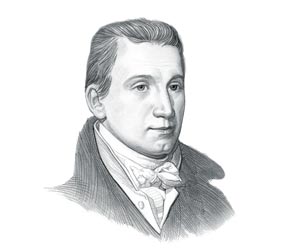|
|
|
|
|
The Panic of 1819 was part of a worldwide financial crisis but the inept management of the Second Bank of America caused the U.S. panic by first extending far too much credit, then quickly restricting it. These banking policies led to runs on state banks, bank closures, foreclosures and bankruptcies. The Panic of 1819 was the first Important financial crisis in the United States and the terrible effects of the panic resulted in the public loss of confidence in the financial structure.
The Panic of 1819 for kids: Background History The political calm in the country led to the period known as the Era of Good Feelings. The government introduced an economic plan aimed at improving the economy of the US. The nation's economic plan was based on a new national bank to provide credit to Americans, taxing foreign goods to raise income and creating a subsidized transportation infrastructure of new roads and canals to enable Westward Expansion to new lands with more settlers becoming farmers. The plan was initiated by Henry Clay and was called the 'American System'. The establishment of the Second Bank of the United States was part of the economic plan to reach these goals. President James Madison, with the approval of Congress, granted a charter to the Second Bank of the United States in 1816 which was a privately held banking corporation.
What were the Causes of the Panic of 1819? Westward expansion: The government offered vast tracts of western land for sale. This fueled real estate speculation that was funded by increased availability of credit from the Second Bank of the United States and new, reckless frontier banks The number of banks in the United States more than doubled between 1812 and 1819
The Banks were unregulated and began to issue
massive amounts of bank notes. The bank notes were not backed by
gold and silver. In other words bank's capital was based on IOU's State banks were chartered for the express purpose of extending credit to speculators Easy credit was obtained by high-risk debtors including many farmers An International financial crisis emerged (a global credit crunch, banks were restricting credit and loans were being called in)
A trade deficit in the U.S. was caused by a
downturn in exports and strong price competition from foreign goods Demand for manufactured goods also decreased
The bad management of poor banking policies of
the state banks and the Second Bank of the United States William Jones first extending far too much credit and then panicked and restricted it too quickly
In 1819 Langdon Cheves replaced William Jones
as president of the Second Bank of the United States. To combat the
economic crisis he put into place a number of measures
Promissory
Notes
Section 8 of the Constitution permits Congress to coin money and to regulate its value. Section 10 of the Constitution denies states the right to coin or to print their own money.
What were the Effects of the Panic of 1819?
Banks went into bankruptcy - they did not have
enough gold and silver to cover withdrawal requests
The Significance of the Panic of 1819:
Also refer to the article on the Panic of 1837.
The Panic of 1819 for kids: Additional Information |
| US American History |
| 1801-1828: Evolution Era |
|
|
|
|
|
First Published2016-04-19 | |||
|
Updated 2018-01-01 |
Publisher
Siteseen Limited
| ||
|
|

